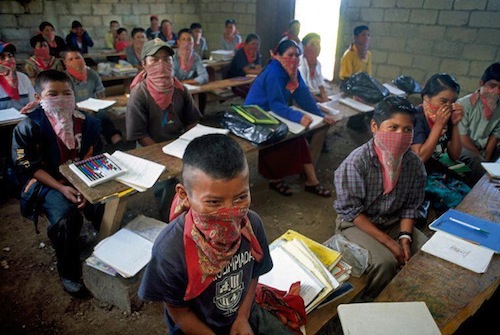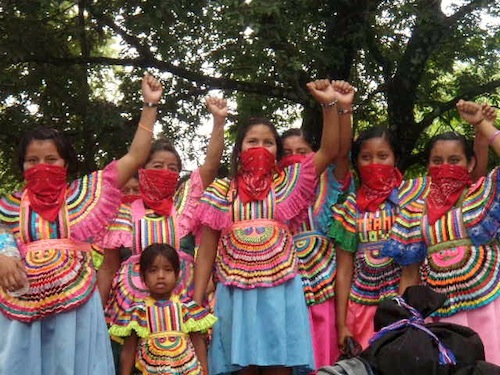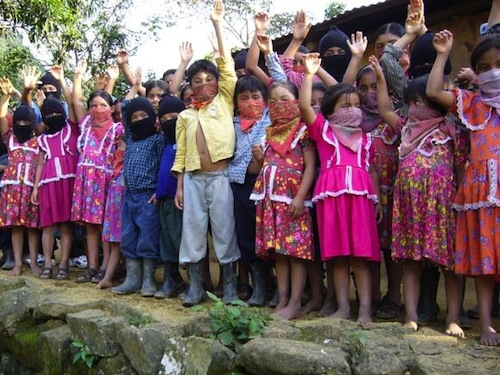Educate in resistance: the autonomous Zapatista schools
- January 2, 2014
Land & Liberation
Zapatista education crosses wide areas of alternative knowledge and being, and offers a space where collective knowledge is aimed at social transformation.
- Author
The first surprise when you get to the Zapatista community of Cintalapa is the contrast between the beauty of the Lacandon Jungle and the Mexican federal army checkpoint, set up outside the ejido.
For the Zapatista children it seems normal that their little bags are reviewed at the checkpoint, or that they are asked questions when they go to the fields with their parents. They have lived through this their entire lives. The adolescent girls seem to be upset that the soldiers look up and down or yell things at them. So the lives of children in the Zapatista territory of tseltales remain full of contradictions.
These are children living between resistance and death, children who attend and together with their parents and siblings build up the autonomous education of the Zapatistas; a form of education based on their own needs and supported by the community through popular assemblies and collective work.
The Zapatista project of autonomy is more than a political and economic proposal for local, municipal and regional self-governance. It constitutes a broad-based social and cultural initiative, of which education is a core element. As a socializing space, the school reproduces culture, practices and discourses; but it can also generate change and resistance, not only in the form of education, but in the subjects themselves, in their forms of community organization and their family relationships.
Although there are differences between municipalities, Zapatista autonomous education is conceived as a university of life. Its objectives and contents arise from the experienced problems, and the possible solutions, through reflection and collective participation.
How it All Began
In 2001, the Zapatista families of the Autonomous Municipality in Rebellion—Ricardo Flores Magón decided to take their children out of school in the Mexican official education system, which did not respect their culture and their history, and which did not teach the children their rights as indigenous peoples, forcing children to forget their indigenous languages and speak only Spanish. Some teachers openly criticized the EZLN and Zapatista families during class, punishing and harshly beating the children, shaming them for being indigenous peasants.
Needless to say, these forms of everyday cultural and physical violence gravely hurt the children, who in many cases returned home crying that they no longer wanted to go to the school of chopol ajualil (bad government). This direct experience of the children is one of the main reasons why the communities decided to organize their own autonomous education project called True Education — a dignified schooling system where both teachers and children are respected.
The 117 communities in the municipality each decided to include the children in the struggle, and removed them from the public schools. At the same time, they began to form autonomous education centers, whose teachers were democratically elected by their communities and trained by experienced external trainers like biologists, historians, agro-ecologists, journalists, engineers and some students in the Municipality Training Center.
Themes and Challenges
The thematic axes of this form of autonomous education are the basic Zapatista demands for democracy, freedom and social justice, as well as the specific needs identified by each village, which have to be resolved through direct democratic assemblies.
The curriculum of the official schools is not removed entirely by the Zapatista schools, but is re-signified through local symbols, so that national and international heroes share space with Indians, the history of the Spanish colonizers is taught side-by-side with the history of the Tseltal, and the values of individualism, competition, consumerism and private property are seriously questioned and replaced with values like the community and solidarity.
 The challenge for autonomous education is to turn the community into a classroom and to incorporate a formal system of Tseltal education, where children learn about planting and harvesting seasons, traditional festivals or about the oral tradition, in order to combine schooling with an indigenous upbringing. Promoters of True Education are not only trained to teach children literacy, but also acquire political-pedagogical tools to help instill the germs of a critical consciousness in the minds of the children:
The challenge for autonomous education is to turn the community into a classroom and to incorporate a formal system of Tseltal education, where children learn about planting and harvesting seasons, traditional festivals or about the oral tradition, in order to combine schooling with an indigenous upbringing. Promoters of True Education are not only trained to teach children literacy, but also acquire political-pedagogical tools to help instill the germs of a critical consciousness in the minds of the children:
Our education is about having a dignified struggle and one heart, so that we can walk together in the same direction. We believe that education is not only about teaching literacy and numeracy, but also about solving problems between our peoples, how to defend ourselves, about our history and how to keep on fighting.
— Hortencia, Tseltal promoter of True Education
The teaching and learning methods in these schools help children to develop a different way of seeing themselves in relation to their immediate reality. Unlike other — official — indigenous schools, they are taught to think of education as inherently political; they are taught how to fight, to take care of their environment and to take pride in defending their indigenous culture and land.
At the autonomous school, we speak Tseltal and we can say whatever is on our minds without any punishments (Gloria, 11 years old).
I like the autonomous school because they respect my word and the teacher doesn’t say ugly things (Julia, 9 years old).
We can play and learn about our rights, and we know what the government does against our communities (Manuel, 12 years old).
Autonomy and Gender
Zapatista education allows children to identify themselves with the project of autonomy. They are fully immersed in the construction of a social and political reality while keeping up with the values of the movement, which is acquired in school and is reinforced thanks to the social and political activities in Zapatista territory. The autonomous school is a place of reflection where children say what they feel and think while constructing their own autonomous identity.
Almost half of the students at the autonomous school are girls, which is curious in an indigenous community: since they are young, girls have to help out at home, care for younger siblings or collect food in the mountain. One reason may be that teachers tend to be more flexible with attendance and punctuality, so that the girls can bring their siblings to the classroom.
 From twelve years on, male youngsters can actively participate in the public and political life of the community and of the municipality, in sports and autonomous events. For female teenagers, however, it is virtually impossible to participate in these types of events — only in exceptional cases in which either the mother or the father has a political position that allows them to build other kinds of relationships:
From twelve years on, male youngsters can actively participate in the public and political life of the community and of the municipality, in sports and autonomous events. For female teenagers, however, it is virtually impossible to participate in these types of events — only in exceptional cases in which either the mother or the father has a political position that allows them to build other kinds of relationships:
When my sister Margarita was 14 years old, my mom decided to take her out of school because she needed to help her with my brothers. She cried a lot. My mom told her that it was not necessary to study since she will get married anyway (Laura, 10 years old).
In the autonomous education system, boys and girls learn about the “revolutionary laws of women” and how to appropriate certain principles and values to be able to transform their family and community life. Girls learn about their rights and how to make decisions, and they are actively engaged in Zapatista organization. Instead of getting married at age fourteen or fifteen, girls decide to become promoters of education, health or human rights, to be part of political committees or become insurgentas, as it does not involve a radical break from community ties.
Autonomous education is an opportunity to form a different type of socialization, arising out of different ideas and practices of gender relations and collective identity. As such, it is not limited to the political, social and cultural spheres: it crosses wide areas of alternative knowledge and being. Zapatista schools are places where collective knowledge is aimed at social transformation.
Source URL — https://roarmag.org/essays/zapatista-autonomous-education-chiapas/


